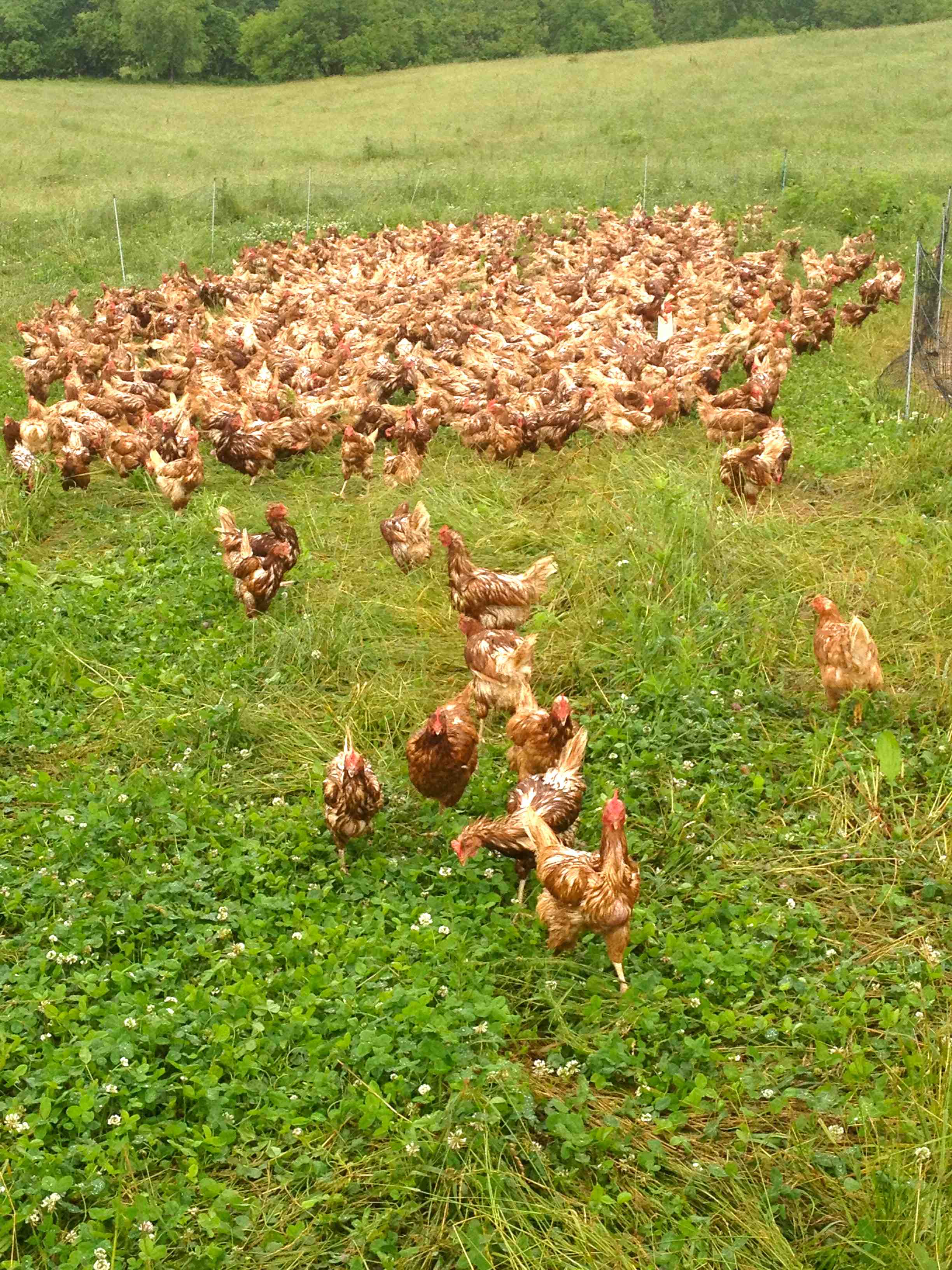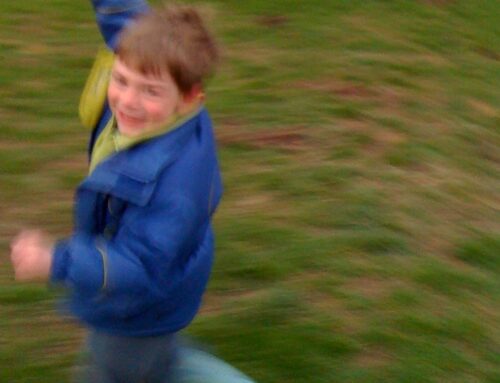
A panoramic view of our free-range poultry field, from the top of our laying coop. If you look carefully, you can see our layers roaming more than a quarter of a mile, beside the white hutch in the upper right of the photo.
The art of grass farming is quickly gaining global respect. A ‘grass roots’ movement in the purest form, intensive pasture management tantalizes us with its broader possibilities. From carbon sequestration and increased rainfall retention, to accelerated nutrient capture, grass farming is increasingly upheld as a shining light of sustainable agriculture. At long last, we’re realizing that many of the answers our ecological problems might lie beneath our very feet.
Yet when it comes to grazing, we often only think of cattle (and to a lesser degree, bison and sheep). But after two decades of raising chickens on pasture, I can personally attest to the positive effect that a well-managed flock of chickens can have on soil fertility. Small flocks can make a big impact, especially on micro to medium sized acreages where chickens might be a better fit than cows. So without further ado, here’s a step-by-by step primer on how to get maximum return for your free-range efforts, while simultaneously healing your soil and generating a profit for your bottom line.
What is Mob Grazing?

This our ‘mob’ of chickens, 1,100 in all, just after a big rainstorm. They are rotated frequently onto fresh pasture.
First, let’s define mob grazing. Simply put, mob grazing is a lot like it sounds: a large ‘mob’ of animals that are eating all at once, in a relatively small area. Have you ever been packed like a sardine at a sold-out concert or summer festival? You know the feeling, an ocean people everywhere you turn. That’s the basic principle of mob grazing: lots of animals on a small amount of acreage.
But unlike a rock concert, on a well-managed farm the mob is always moving. Otherwise known as ‘rotation,’ the tightly bunched group of animals only stays in one place for a short time before moving on. It’s the farmer’s job to ensure that there’s always plenty of pasture for the mob so they never go hungry. Picture it as the “ultimate, never-ending buffet line.”
So why is this such a great idea? Because it’s precisely how animals behave in nature. Cattle move in herds, and sheep move in flocks. There’s safety in numbers, and animals know this. No one wakes up in the morning wanting to be eaten by a wolf.
It’s through mimicking these natural behaviors that farmers can greatly increase soil fertility. As the cattle move, they trample the grass, effectively ‘mulching’ the field where they’re grazing. While getting their fill to eat, they also crush and ‘waste’ a lot of grass as they go. But just like mulching a flower bed or garden, this ‘waste’ isn’t actually wasteful at all. It creates a moisture barrier for the topsoil, trapping crucial rainfall. At the same time, it helps to reduce surface temperatures, and fosters a favorable habitat for beneficial earthworms and insects. Instead of driving to the Home Depot for bags of mulch, the farmer puts the animals in position to do this themselves.
Better yet, because they are tightly bunched, the animals spread their manure and urine evenly across the field. Whereas five or six cows might only poop on a handful of spots in a one acre field, fifty cows in the same area can do ten times as much fertilizing. Of course, fifty cows can’t remain on an acre for very long, so it’s up to the farmer to keep the group moving, often once or twice a day. Graze, trample, poop and move. If everything goes right, the pasture will get a month or more to ‘rest,’ allowing the grass to recover, process the natural fertilizer, capture carbon in its roots and rejuvenate itself. It’s one big circle of life, and the practice holds great promise for the future of sustainable agriculture.
Mob Grazing with Chickens
Now that we understand the basic concepts, how do we do this with chickens? First of all, we need to think smaller scale. An average chicken is only three or four pounds, as opposed to a fifteen-hundred pound cow. Needless to say, a little chicken can’t trample grass as well as a full grown steer! Or… can they? If properly managed, could chickens graze as well as a mob of cattle? In my opinion, the answer is a resounding ‘yes’. Here’s how.
 First things first. Thank you, Thomas Edison: Without electricity, this might not be possible. It all starts with electrified poultry netting. Why electrified netting? Because foxes, coyotes and neighbor’s dogs LOVE to eat chickens. By putting a ‘hot’ current on the net, not only do we keep our chickens from being slaughtered by predators, but we can effectively control where our birds graze… and how many of them are grazing in the same location.
First things first. Thank you, Thomas Edison: Without electricity, this might not be possible. It all starts with electrified poultry netting. Why electrified netting? Because foxes, coyotes and neighbor’s dogs LOVE to eat chickens. By putting a ‘hot’ current on the net, not only do we keep our chickens from being slaughtered by predators, but we can effectively control where our birds graze… and how many of them are grazing in the same location.
On our farm, it all starts with the Hub System. This is an idea I modified many years ago from Timothy Shell, and it works fabulously for chickens (and pigs, too). The basic premise is reminiscent of a wagon wheel. The center, or ‘hub,’ is where the coop sits, remaining stationary. The ‘spokes,’ extending out from the hub, form a circular perimeter (the wheel itself). To illustrate exactly what I mean, I’ve included these diagrams to the right.
In essence, we roll or drag a mobile coop onto a pasture, where the chickens take shelter at night, or retreat during inclement weather. They have access to the outdoors 365 days a year, even in the snow. (I’ve written a comprehensive blog about how all this works HERE, along with an accompanying videos HERE and HERE.) From the stationary coop, there are access doors cut all the way around, so the nets can operate like ‘spokes’ on the wagon wheel. These are long, narrow alleys that the chickens access daily, providing them with fresh pasture each morning.
 But how do we get them to trample and mob graze? That’s the real trick, where lots of patience and skill enters into the equation. In chronological order, here’s a slew of insider tips to get your flock of chickens mob grazing every bit as well as a herd of cattle.
But how do we get them to trample and mob graze? That’s the real trick, where lots of patience and skill enters into the equation. In chronological order, here’s a slew of insider tips to get your flock of chickens mob grazing every bit as well as a herd of cattle.
Getting your Chickens to Trample Like Cattle
The first week on pasture actually means that the chicks (and I’m referring to meat chickens here, but the same goes for 17 weeks old laying pullets) aren’t actually ‘chicks’ at all: they are 3-4 weeks old, and recently removed from the safe confines of the brooder. Our hutches are 12 feet by 16, and we stock them with 200 birds apiece. Once we put them inside the hutch (deep bedded 2-3 inches with pine shavings, and manually flipped every morning with a pitch fork), we keep the birds inside an additional 3 days to get them acclimated and ‘homed in’ to their new surroundings. On day five we open a door onto pasture and move their feed troughs JUST outside the door, to encourage them to venture outside. It’s a big scary word out there, much like our first recess in Kindergarten. For the next two or three days, we keep the feed close to the entrance where they can see it, to build comfort.

200 Cornish Cross chickens at week 7. We never trim the pasture ahead of them, which eliminates extra tractor work. For feed, we hand-allocate our broilers 1/3 lb. feed per bird per day, and our layers 1/5 lb. per bird per day.
At this time we keep the net very wide, at least a fifteen foot width. This allows the chickens to spread out, receive a shock from the net, but not panic and become entangled. When the birds are tightly packed together and one gets a shock, they will scatter like a school of fish, and multiple birds will flee straight into the net and become caught. By spreading out the net on the first week we mitigate this risk, and allow each bird the chance to learn about the net without jeopardizing the rest of the flock. During the first week we don’t rotate the net, because the birds are so small they don’t trample much pasture.
When night falls the birds return to the hutch, and I close the door (although never with the layers, so as not to interrupt their natural biorhythms). The first couple of evenings I have to shoo them in till they get the idea. This makes moving the net in the morning a piece of cake.

Inside the hutch. Deep bedded, at turns cozy and cool… and built like a Chicken Fort Knox. If everything goes right, we only lose about 5% of our birds to mortality and predation.
At week five, the trampling really starts. By now the birds are hankering for their door to be opened each morning, knowing that feed is waiting for them outside. But on the morning of week five, we tighten up the net to a three-to-four foot wide alley, and move their feed about halfway down the run. A single, standard net from Kencove or Premier is typically 165 feet, so this basically provides them an 80 foot run. Each day during week five, we keep moving the feed troughs further down the run, until by the end of the week it’s all the way at the end. From week six through week nine (when the birds are butchered), the nets are moved each and every morning. And a good thing, too… it’s a Trample-Poop-Looza out there!
People tell me that Cornish Cross chickens are lazy, or disposed to sitting all day long. Hogwash! If properly trained and motivated, these birds are superior tramplers and excellent grazers. If you’d like to witness Cornish Cross chickens that—at full maturity—sprint across the pasture, then come visit our farm. But keep out of their way, or they might knock you over as they trample the grass.
What are the Results?

A side-by-side view of a ‘littered’ run and a ‘fresh’ run. We always set up two nets at once for our layers, to make the weekly transition seamless: one door closes, and a new door opens. (See earlier diagrams for reference)
It’s a long known fact that grass loves nitrogen. But chicken manure isn’t just loaded with nitrogen; it also contains beneficial levels of phosphorus, potassium, magnesium and calcium. These are all important nutrients for a well-balanced soil. Because the manure is so potent, it’s paramount that the grass is allowed to ‘rest’ after a good trampling for at least 30 days or longer. This allows rain, insects and microbes to break down the manure into fertilizer, and also speeds pasture recovery to greatly reduce nutrient run-off. We’ve worked hard to trample and fertilize all that grass; now, lets take the extra steps to make sure our efforts don’t go wasted.
On our farm, we dedicate one 15 acre field to poultry each year, then ‘rest’ that field for at least one full year without any chickens. During the poultry year, our chickens might graze a particular swath of field 10 times (with 35 day rests in between). But during the off-year, we give the field time to process all these inputs so as not to overburden it with fertilizer, or allow parasites and pathogens to accumulate. Just like in nature, the animals are always moving. We try to mimmic that behavior as well. (And by the way, the entire time that the chickens are in the field, we’re also rotating our cattle and sheep through, otherwise known as multi-species grazing).
Final Thoughts

Yes, we even free-range our chickens in the snow. If these birds look motivated now, just imagine how they’ll react when they see spring pasture!
Will mob grazing with chickens save the world? Like anything else in the sustainable agriculture movement, it’s simply a part of the solution, another puzzle piece in the carbon/nutrient cycle. But grazing with chickens is especially important due to its scaleability. Poultry is perfectly suited for smaller acreages, and major impacts on soil fertility can be accomplished with a well-managed flock of 200 birds. (200 birds, incidentally, is the minimum economy of scale I would recommend to those hoping to financially break-even on raising chickens. 400 is a better number yet, and gets you headed towards making an actual profit).
Don’t be fooled by the head-scratchingly romantic testimonials of raising free-range chickens. This is genuinely hard work, with a long-term payoff. But I’m here to tell you: this can be done, and done profitably. Moreover, the benefits are far greater than simply raising chickens. We can scientifically improve soil fertility, capture atmospheric pollutants, and all the while produce the world’s tastiest eggs and chicken.
What’s not to like? Let’s make mob grazing a cock-a-doodle do, not a cock-a-doodle don’t. Follow these tips, and you’ll be raising healthier chickens for a healthier planet in no time at all.
Check out my books!












Fascinating! I have always had problems with nets shorting in tall grass. How do you deal with that problem?
Ryan,
I use a 200 mile plug-in fence charger, which really helps. But sometimes even THAT fails, especially in tall grass. The best thing to do is to keep as short a distance between the charger and the chickens as possible… or upgrade to a bigger charger!
Thanks Forrest – that bigger charger would probably help a lot. Currently we use a portable solar charger from Premier One, but our soil is so sandy and dry that it only works well if I mow the grass before moving the fence. To me, mowing kind of defeats the purpose of mob grazing chickens.
We have our current flock of layers (about 50) in a mobile coop with the portable fence around it. Each day I open the fence and allow them to roam around the pasture. Not mob grazing exactly, but they do help a great deal with our grasshoppers.
Our property is too small to support more than one or two cows, so it’s great to see somebody mob grazing with just chickens. I love Joel Salatin, but it’s sometimes discouraging to try to scale his ideas down to our size.
Thanks Forrest for the article, really enjoyed it, and your book! One question, in reading your book I know you don’t do any haying on your farm, so what do you do with the 15 acres the year it’s resting with no animals on it?
Hi Forrest, this article was a joy to read. As a lover of feathered things and current student pursuing a degree in sustainable agriculture in Vermont, this pastured production model is very appealing to me as I think about my future. I had a few questions, though: What do you do about storing and distributing their feed and water? Do you have grain bins and water tanks nearby?
Hi Darienne,
The water is piped via a frost-free hydrant and pressure reducer through 1-inch pipes to Kuhl bell waterers. We feed the birds twice a day by hand, 1/4 pound per day for the layers, and 1/3 per day for the broilers. Hope this helps!
Hello Forrest, thanks for the information, this will be very helpfull for us. Can you please send me the information of where can I get the fence? The company that produce it. Thanks a lot for the article and for your helpfull
Premier and Kencove are two companies that I use. A quick Google search should pull them right up!
ok, so I have 1 acre and that is it.. How many birds can I run on an acre? Can you tell me how to figure that out?
Without knowing much about your acre, I’d say 2 batches of 50 broilers from May-October or 15 laying hens year round would be a good start…
Hello I like the concept, I have a small area to pasture a total of 5acres of great pasture and 5acres of poor… I really donot want to have that much chickens have you seen any success with rotating sheep and after they graze bring in the chickens,I was thinking around 10 sheep how many chickens would you suggest with the sheep?
Forrest,
For you feeding is that 1/3 lb per bird per day?
Curious if you have had any loss from aerial predators? We’d like to try this concept this spring.
Yes, we always have some predation. The goal is to keep mortality to no greater than 5%, which is typically where we operate.
Hi Forrest, Just a quick question – on your quick tips sheet, you say to maintain a reading of 4.0 on the fence – 4.0 what? This seems high to be the joule output of the energizer – since Kencove recommends 0.25 per net as a minimum, this seems like the latter be much too low to be of use against predators! Also, any ideas on how many joules per (single 165′ net) keeps the output at 4.0? Thanks, Erin
Erin, he means 4,000 volts I believe. The tester(assuming you have digital) should say 4.0, which you multiply by 1,000 to know how many volts your fence is putting out. Make sure and test as far away from the energizer as possible.
Are your layers producing dark-yolked eggs?
Good job forrest
nothing like some fried chicken
[…] 1. Mob Grazing with Chickens by Forrest Pritchard. […]
Great idea! I do have a few questions, though;
(1) To echo a person above, what do you do with the 15 acres of field while it is resting from the chicken and livestock rounds? Do you do any planting?
(2) Have you considered combining your current method with the multi-species, mob grazing with “resting” cover crops , and then roller-crimping it down to further improve soil nutrition and water retention? If so, what would this look like from a practical perspective in terms of timing/scheduling, before you brought the birds and other animals back in?
The resting period allows the vegetative cover to rebound; in our climate, there’s rarely any need for cover cropping or reseeding if the birds are rotated every two weeks. The rare exception is when there’s an extraordinary rain event (2 inches or more in one day), then we’ll top dress the ground with a grass/legume seed mix. Ideal rest times are roughly 50-60 days. As for crimping, I try to keep my tractor off the field as much as possible– less diesel, compaction, repairs and exhaust!
🙂
-Forrest
Hi Forrest, I just found this great site. Thanks for publishing it. My organic feed supplier recommends only 2 – ounces of feed daily per layer. Is this enough in your opinion? Our birds graze all day every day.
Also, I can plant some special type of grass if you think one is better than another. Right now we seem to have crabgrass mostly believe that I can do better.
Best Regards,
Jim
I’d suggest 3.5-4 oz. per day, depending on forage availability. As far as planting goes, focus on legumes (clover, vetch, lespedeza, etc.) and the grass will follow!
Thanks my friend. Take care and have a good day.
I have just been reading about Allan Savory and I watched his TED talk video. I like the idea and was wondering if your method is based on Mr. Savory’s practices? I would like to understand the deep, deep science behind this. Do you know of any research articles that explain this in great detail?
If you are too busy to reply I understand perfectly well.
Thank you for the great website and help.
Sorry for being a pest. I have already got some of the ground turned over ready for seed. Could you please recommend chicken forage seeds that can be planted now or soon?
Thanks,
Jim
If the ground is turned over, cover crop it immediately with italian rye grass… and cross your fingers that it grows this time of year! In the future, no tillage is necessary. Simply frost seed clovers in February and March straight onto the ground.
Thanks Forrest, I am ordering seeds now.
[…] thus increasing the fertility of the soil. New sustainable practices now utilize chickens in a rotating movement with grazing animals so that when your cows and sheep come back to the same patch the chickens have […]
[…] only have they scratched and eaten all the pests they could find, but they’ve done a lot of mob grazing and […]
Forrest,
Thanks for the article! I run a vegetable farm in Virginia and I plan to raise pastured laying hens on a few slivers of land along my crops. I will maintain a small buffer between the chickens and the crops to maintain sanitary conditions. I want to raise at least 100 layers and I have at least four 80ft long 7ft wide alleys to rotate them in. Do you think this is enough pasture? If so, how often do you think I should rotate them?
Thanks,
Patrick
Yes, that’s plenty of space. Rotate every two weeks, and top dress with a little cover crop seed if necessary. Good luck!
Great article! I was curious how often you clean out the coops and if you have problems with mites, as well as what are your thoughts on a mobile coop rather than a stationary coop for this type of grazing?
Thanks Jason
Even though, my goals and geography, mean that the methods would need to be very different. The basic methodology and science apply to what I want to do. My goals differ because my property is very steep and hilly. My goals are first to reduce fuels for wild fires, and money made will only offset costs, not profit. Fences will need to be permanent, and I may use heritage turkeys instead of chickens. Thanks for the great article.
Hello, I am looking into starting my own humane organic pastured eggs, I live in southern california so the weather is great year round. I would like to know having 1000 layers on 2.5 acres. About how often should I rotate the clock to another 2.5 acres? I have 20 acres available. Thank you
Every two weeks, year round.
How long could one theoretically make the alley run? is there a reason to limiting it to 80 feet other than standard fencing size?
Yes, as long as you like! In the intervening years since this post, we’ve extended it up to a quarter mile.